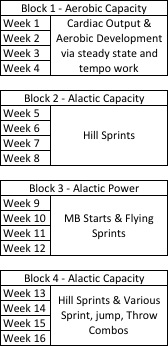Written by Mike Guadango
I had made a post regarding block sequencing for different energy systems:
“Mike, Do you favor mixed training methods in a concurrent fashion for low level athletes (training age under 1 year) or do you still favor a block system methodology and why?”
Typically, the block system is designed for elite level athletes, focusing primarily on singular biomotor tasks. I say “typically” because in theory, the elite athletes should have elite preparation. And if you’ve seen this video, you know that’s not the case:
Essentially, what I perform is a general scheme of bodyweight GPP and a block formatting of energy system training for low level athletes. Obviously sport/goal pending, but usually performing aerobic capacity first, alactic capacity second, alactic power third and then back to alactic capacity. Something like that is not out of the ordinary. I performed a similar scheme this summer with my collegiate football players.
I then received this question:
“Mike, could you please further explain the sequence of working on alactic capacity first, than alactic power and finally capacity again? Maybe with an example from the training of your football players. Has this something to do with the relative low outputs at the beginning? Thanks!”
In this case I performed an aerobic block first. I wanted to improve aerobic capacity for obvious reasons and teach proper running mechanics submaximally so the athlete wouldn’t:
1. Injure himself
2. Improve general work capacity (get better at doing any kind of work)
3. Improve specific work capacity (get better at running)
4. Improve ability to recover
Making corrections submaximally is way easier than attempting to do them at top speed. Gotta learn to walk before you run. The athlete needs to be able to understand what he is trying to accomplish before he actually does it.
Motor learning:
- Unconscious incompetence (The athlete doesn’t know what he’s doing wrong)
- Conscious incompetence (The athlete is thinking about what he’s doing wrong)
- Conscious competence (The athlete is thinking about what he’s doing right)
- Unconscious competence (The athlete is not thinking about what he’s doing right)
Performing submaximal movements in a controlled setting allows for the athlete to perfect form with reduced stress. This is key for success. It allows the coach to keep cues to a minimum, while keeping learning efficiency to the maximum.
“Correct one thing at a time and you have an 85% success rate. Correct two and it immediately drops to 37%. Good freakin` luck with three!” – Buddy Morris
Next, I moved on to an Alactic capacity block. I want to limit the rest and stress so the athlete doesn’t produce more force than he is currently capable of handling. Limiting forces at this current stage for this athlete was important.
How do you limit force? Have him run hills and rest minimally (obviously without it becoming a lactic event.) Hence: Alactic Capacity.
Once I was confident the athlete knew how to produce force and was able to handle what he produced, I felt it was time to allow him to produce even more. Time to put him on flat ground and progress him to perform various starts on M&F and on W have him perform flying sprints.
Because this athlete is a RB acceleration development is paramount. I usually work on that twice per week. But top speed work is VERY important to improving speed, strength and work capacity.
During top speed, athletes will produce up to 5-6x their bodyweight on each foot for less than a tenth of a second. That’s a tremendous amount of force. I worked in flying sprints to improve his force outputs which in turn will improve his speed reserve. Remember, if we increase maximal outputs, operational outputs increase as well.
More rest = More intensity
The more force you can generate (at the proper angles obviously), the easier it is for you to go faster.
Lastly was the final Alactic Capacity block. Now that the athlete has gone faster, he needs to be able to maintain that speed, or at least a high percentage of that speed for multiple reps. Otherwise, what good is the speed to a RB who’s just one and done. Not to mention, I need to prep him for the rigors of camp. It’s a shame that I’m preparing him for activities that aren’t really football related…ugh…
Moving on –
I have various starts at various angles, coming off of various jumps, holding and throwing MBs in various directions in parameters of training alactic capacity. Though you can’t actually simulate camp, this will help the system cope with camp play.
Here’s a basic one to spell it out for you guys:
Mike is a currently a coach at DeFranco’s Gym in Wyckoff, NJ. He studied under Buddy Morris and James Smith while at the University of Pittsburgh and has also studied at various physical therapy practices. He has coached levels of athletes from Pro-Bowl, MLB, to pre-pubescent athletes and has also consulted for high caliber athletes worldwide. Website, Facebook, YouTube, Twitter







